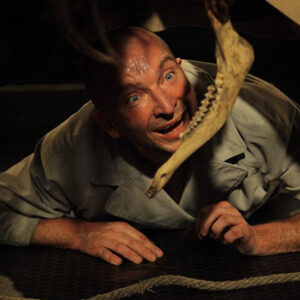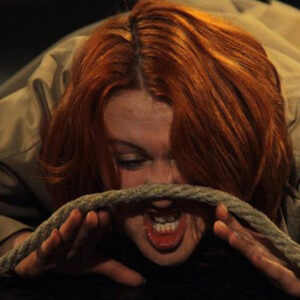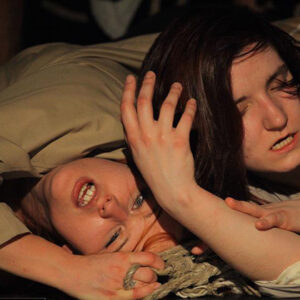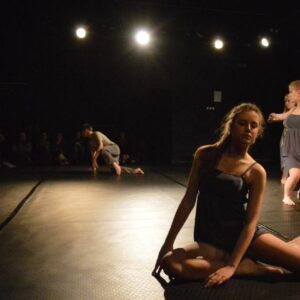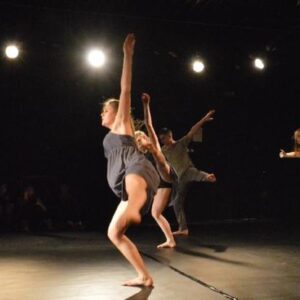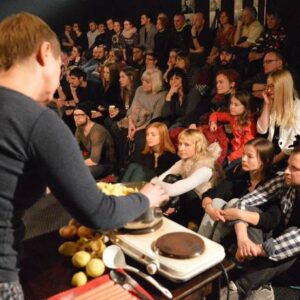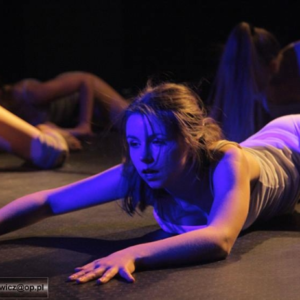In the sphere of movement, outside the sphere of dreams
5 years of the Dance Theater Studio, 2016-02-26 - 2016-02-28
On the last weekend of February, at the Department of Culture Animation and Andragogy of the University of Zielona Góra, there was a review of performances under the banner of SFERA RUCHU, organized by the Dance Theater Studio on the occasion of her fifth birthday. In addition to four original premieres of dancers from Zielona Góra, the event was graced by guest performances of Akro dance theaters from Toruń and Enza from Słupsk and the Terminus A Quo Theater from Nowa Sól.
On the first day of the jubilee, viewers had the opportunity to watch two short performances prepared by the Toruń dance theater company. The shows were inaugurated by the performance "Buja", choreographed by Joanna Miś-Fudala. The ambiguous title, which could be understood both as a reference to a floating navigational object, and to a cluster of words "because I ..." used hastily by the interpreter, suggested that it will be a story of determination and a constant struggle to stay afloat. Indeed, the dancers (Aleksandra Dziwulska, Kinga Ulatowska, Aleksandra Lichocka and Krzysztof Skibicki) showed the sad everyday life of an ordinary representative of Western civilization, who forces himself to constantly struggle and run faster in order to keep up with the changing reality. However, what is worth emphasizing,they did not limit themselves to presenting the process itself, in which the protagonists participate, but emphasized its consequences. The characters created by them froze again and again in full of suspense, strange gestures, which can be interpreted as a reference to the flag code used on ships, with the help of which the lost sailors ask for the right direction (in order to constantly float on the surface, you need to know where to flows) or to the neurosis of obsessions caused by constant stress and oppression of social conventions, shaping not only our minds, but also our bodies, more and more subordinated to commonly accepted methods of self-presentation.The characters created by them froze again and again in full of suspense, strange gestures, which can be interpreted as a reference to the flag code used on ships, with the help of which the lost sailors ask for the right direction (in order to constantly float on the surface, you need to know where to flows) or to the neurosis of obsessions caused by constant stress and oppression of social conventions, shaping not only our minds, but also our bodies, more and more subordinated to the generally accepted methods of self-presentation.The characters created by them froze again and again in full of suspense, strange gestures, which can be interpreted as a reference to the flag code used on ships, with the help of which the lost sailors ask for the right direction (in order to constantly float on the surface, you need to know where to flows) or to the neurosis of obsessions caused by constant stress and oppression of social conventions, shaping not only our minds, but also our bodies, more and more subordinated to the generally accepted methods of self-presentation.where it goes) or to the neurosis of obsessions caused by constant stress and oppression of social conventions, shaping not only our minds, but also our bodies, increasingly subordinated to the generally accepted methods of self-presentation.where it goes) or to the neurosis of obsessions caused by constant stress and oppression of social conventions, shaping not only our minds but also our bodies, more and more subordinated to the generally accepted methods of self-presentation.
The play "Traces", developed and performed by Joanna Miś-Fudali and Marta Pańka, was a story about becoming, the passage of time and the accompanying inevitable changes that each of us struggles with. The dancers created a very interesting and coherent composition, based on a complex artistic idea, their arrangement depicted the struggle of two forces, which could be interpreted in many ways, resembling the inner struggle of a man who wanted to develop and move on, but at the same time blocked by fears and worries about what would happen when he crossed his limits. At the same time, however, it also evoked an association with a traditional intergenerational conflict, based on the rebellion of children who promise themselves that they will not become like their parents and want to follow their own path at all costs.Set in this context, the struggles of the dancers evoke connotations with many film works, such as "Gray Gardens" or "Arizona Dream", depicting the difficult relationship between mother and daughter.
By far the best performance of the Toruń group was the show "Onions with sausages", presented on the second day of the review, realized as a project by PańFu. The performance, prepared and performed by four dancers (Joanna Miś-Fudali, Magdalena Bujalska, Marta Pańka and Małgorzata Pośpiech) with admirable virtuosity and attention to detail, tells a story wrapped around the table - an object culturally perceived as a symbol of family ties. Meetings at the table during daily meals, games, rituals, celebrations and important discussions have been described for centuries as special moments bringing people together, who after a whole day work, they can finally be together. The "mistress" of the table, thanks to whom and through whom this momentous act takes place, is, of course, a woman - a wife or mother, who cooks dinner according to her great-grandmother's recipe,carefully kept in a bulky notebook full of wise advice. The performance of PańFu ironically collides this myth with reality. A clasped composition, according to which the action begins and ends with the title onion soup with sausages - in the first scene cooked by one of the actresses, and in the last scene eaten by all four of them - creates the atmosphere of a home meeting at dinner (even in the audience there are delicious smells!). However, the idyllic atmosphere quickly turns out to be an illusion. Successive dancers sitting at the table perform a series of fainting movements indicating sleepiness, fatigue and resignation. Gradually built up, they form clear sequences depicting the daily routine. This brings to mind the cult animation by Rybczyński entitled "Tango", showing twenty people,who are so focused on doing what they are doing that they cannot even see each other, even though they are in the same room. When the protagonists finally come out of this trance, the table is placed vertically by them. It then creates a wall that cannot be overcome. One of the dancers tries to climb it to get to the others, but all her efforts fail. Looking for another way to bypass the barrier, he knocks on the table as if it were a closed door, but in response he only heard "busy". In "Onion with sausages", the table (an exceptionally well-crafted prop) turns out to be something like a closed portal. Paradoxically, it begins to function as a symbol of disagreement between people who are too tired or busy to find time for a normal, honest conversation.Articulating the recipe for soup in many different languages at the end of the performance emphasizes the universality of this phenomenon in the modern world.
The lobbies on the presented performances on the second day of the festival were dominated by the controversial performance of the Terminus A Quo Theater, entitled "Take it easy". Directed by Edward Gramont, the show, inspired by William Burroghes's "Naked Lunch" and George Orwell's "1984", is a striking surreal vision of life in a totalitarian state tormenting citizens (played by: Magdalena Budzyniak, Adriana Boś, Agata Wojtkowiak, Agnieszka Małecka, Cezary Molenda and Konrad Gramont) Filled with fear and beastly, they gradually fall into madness.
The way of depicting paranoia takes an exceptionally fresh and effective form. In the first part of the performance, the actors dressed in gray trench coats circulate around a symbolic circle delineated with a rope, symbolizing the modes of the ruthless system. You can see at first glance that the heroes could free themselves from it. Manipulated and entangled in its machine, they dully repeat the syllables of the words overheard in the informative noise, arranging them into gloomy stories that reflect their obsessions. The exceptional length and monotony of this scene overwhelms viewers, making them feel like part of a terrifying system. Then, a new, expressive character joins the group of heroes - a rebel who contrasts with their behavior, and real madness breaks out on the stage. The heroes start shooting each otherthey try to net the revolutionist, losing themselves in a crazy chase, stacking their bodies in a disorderly pile, and telling obscene tales of life in Anexia.
The tension that organized the performance affected the audience a lot and apparently made a great impression on the audience. It is worth noting that its strength was determined not only by the original phantasmagorical vision of Edward Gramont, but also by the efforts of the actors, for whom the incredible pace of the show was certainly a real test of physical endurance.
The last performance presented as part of the SPHERE OF MOVEMENT on the stage of the Department of Culture and Andragogy Animation was "Niepodobiestwo", performed by the Enza Dance Theater. The premiere performance, choreographed by Gabriela Keller-Janus, concerned the struggle of an individual with the conditions among which he comes into the world and which sooner or later may Although the whole arrangement seemed a bit chaotic, the dancers (Klaudia Janus, Maja Stankiewicz, Klaudia Szamal, Martyna Majewska and Wiktoria Banaszewska) managed to accurately convey the inner tear that accompanies adolescent young people who try to break with the patterns imposed on them. the moment they crawl around a tight confined space was really electrifying!
Despite the joyful atmosphere accompanying the celebrations of the fifth jubilee of the Dance Theater Studio in Zielona Góra, the performances that added splendor brought a sad reflection on the condition of modern man. They reminded the audience that the reality around us is changing faster and faster, which makes it easier to think of it as a sphere of movement than of dreams.
Agnieszka Moroz
The Theater Journal
March 5, 2016

